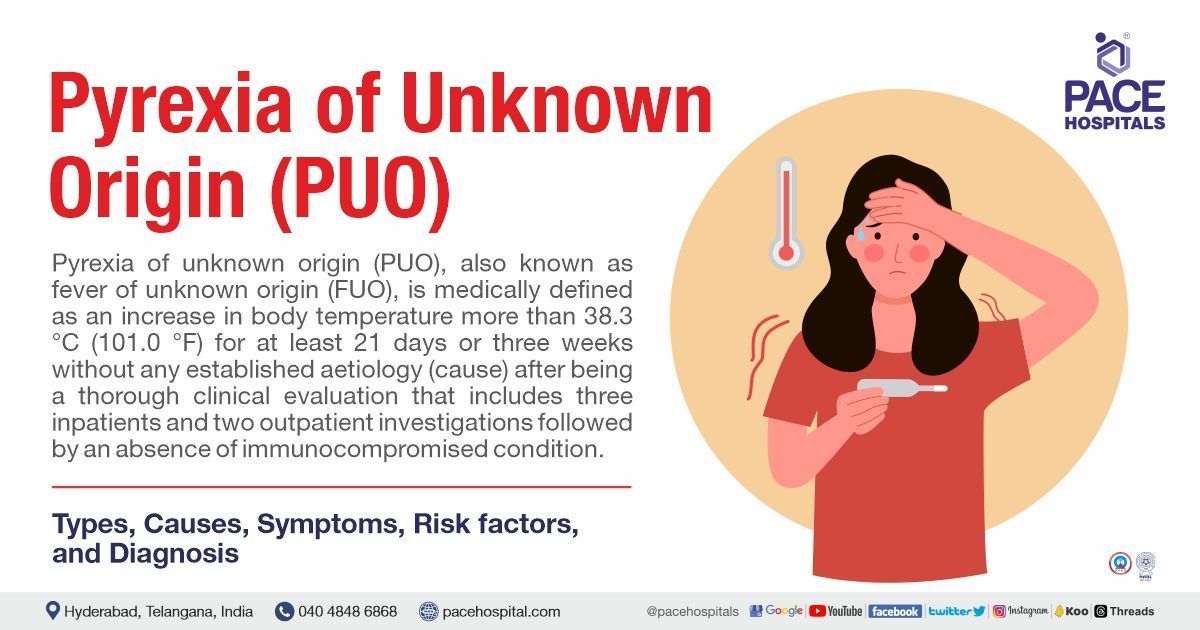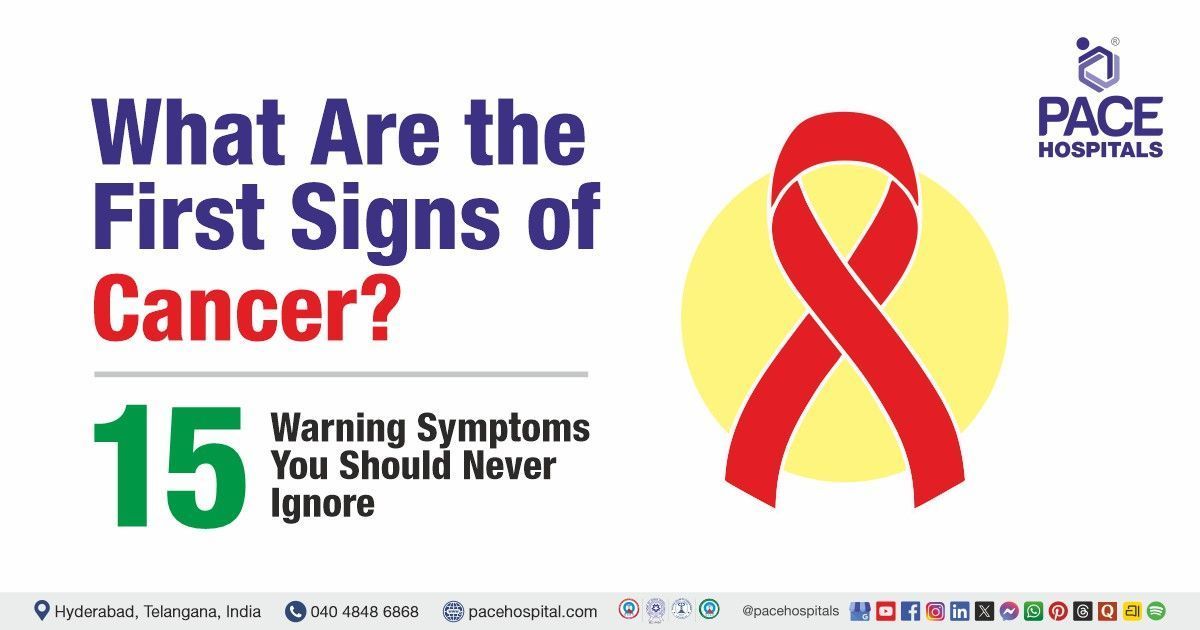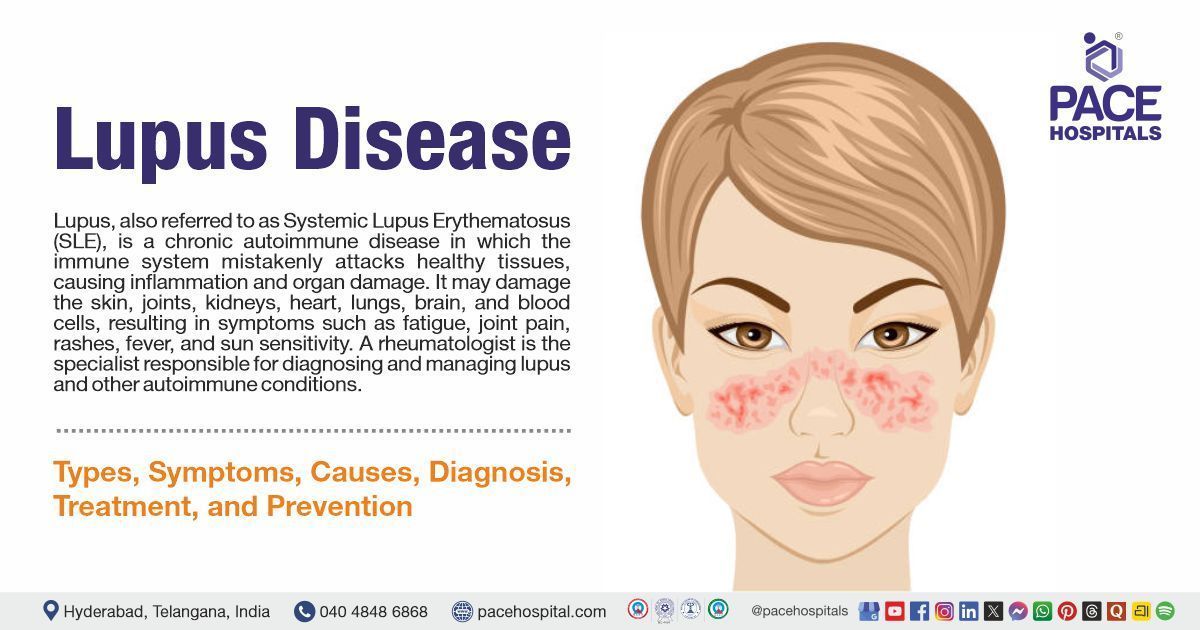Pyrexia of Unknown Origin – Causes, Symptoms, Types, Risk Factors, Treatment
Pace Hospitals
PUO full form in medical - Pyrexia of unknown origin
Pyrexia of unknown origin (PUO), also known as fever of unknown origin (FUO), is medically defined as an increase in body temperature more than 38.3 °C (101.0 °F) for at least 21 days or three weeks without any established aetiology (cause) after being a thorough clinical evaluation that includes three inpatients and two outpatient investigations followed by an absence of immunocompromised condition. Most febrile illnesses either resolve before a diagnosis or develop distinguishing characteristics that lead to a diagnosis.
FUO medical abbreviation - Fever of unknown origin
Fever of unknown origin (FUO), where the exact cause of the fever is idiopathic (unknown) after a thorough clinical evaluation. Fever is a symptom of an infection, which is a common condition; however, it may also result due to inflammation, allergic reactions, drug reactions, undetected cancer conditions, and autoimmune disorders.
Types of pyrexia of unknown origin (PUO) / fever of unknown origin (FUO)
The pyrexia of unknown origin (PUO) classification is based on its characteristics, vulnerabilities and evaluation time. The following are the PUO types:
- Classical PUO disease
- Nosocomial PUO disease
- Immune deficient or Neutropenic PUO disease
- HIV-associated PUO disease
Classical PUO disease: This category includes patients with standard criteria (temperature > 38.3°C for more than 3 weeks) and evaluation of three hospitalisation days or three outpatient visits or one week of ambulatory investigations. Malignancy, collagen vascular disease, and infection are the common causes of classical PUO.
Nosocomial PUO disease: This category includes hospitalised patients with body temperature > 38.3°C for 3 days in several scenarios who are in acute care. The patient is admitted for other reasons besides fever and experiencing increased body temperature due to hospitalisation. Drug-induced, septic thrombophlebitis, pulmonary embolism, sinusitis and clostridium difficile enterocolitis are the common causes of nosocomial PUO.
Immune deficient or Neutropenic PUO disease: This category includes patients with neutrophil count less than 500/microliter or expected to fall the count in one to two days, having fever more than 38.3ºC (101ºF) for 3 days on several scenarios. It usually occurs in patients with compromised immune system s. Aspergillosis, herpes virus, candidiasis and opportunistic bacterial infections are the common causes of immune deficiency or neutropenic PUO.
HIV-associated PUO disease: This category includes patients with increased body temperature (>38.3ºC) for more than four weeks (outpatient) or three days (inpatient) with confirmed human immunodeficiency virus infection. Pneumocystis carinii pneumonia, drug-induced cytomegalovirus, Kaposi's sarcoma, and Mycobacterium avium-intracellular complex are the common causes of HIV-associated PUO.
Pyrexia of unknown origin - PUO causes
(PUO) Pyrexia of unknown origin causes are majorly categorised into four groups.
- Infective
- Non-infectious Inflammatory diseases
- Neoplastic
- Miscellaneous
Infective: It comprises 17-35% of cases that are caused by bacterial (specific and non-specific), fungal, parasitic, and viral organisms. The most frequent infectious conditions associated with pyrexia of unknown origin (PUO) or fever of unknown origin (FUO) are abdominal or pelvic abscesses, as well as tuberculosis (particularly in extrapulmonary locations). Diverticulitis, malignancy, trauma, and perforated hollow viscera (such as those seen in appendicitis) are associated with intra-abdominal abscesses. Infections such as sinusitis, osteomyelitis, subacute bacterial endocarditis, and dental abscesses can also be considered potential causes of PUO / FUO.
Non-infectious Inflammatory diseases: These comprise 24-36 % of cases. Noninfectious Inflammatory diseases are usually autoimmune diseases. Adult Still's disease and temporal arteritis are currently the most prevalent autoimmune causes of pyrexia of unknown origin (PUO) or fever of unknown origin (FUO). Older patients with multisystem inflammatory diseases (polymyalgia rheumatica and temporal arteritis) are most frequently linked to PUO / FUO.
Neoplastic: It comprises 10-20%of cases. Patients with pyrexia of unknown origin (PUO) or fever of unknown origin (FUO) frequently have malignancies that might be challenging to diagnose, including chronic leukaemia, lymphoma, renal cell carcinoma, and metastatic tumours.
Miscellaneous: It comprises 3-15%of cases. Pyrexia of unknown origin (PUO) or fever of unknown origin (FUO) can be caused by a variety of unrelated pathologic diseases, the most frequent of which is drug-induced PUO / FUO.
Pyrexia of unknown origin - PUO in children
Pyrexia of unknown origin in children is a common problem that usually ranges between 10 and 21 days. The PUO / FUO in children is characterised by an increase in body temperature of 38.3 °C that lasts for at least ten days with no definitive cause after initial outpatient or inpatient workup.
The major cause of pyrexia of unknown origin (PUO) or fever of unknown origin (FUO) in children includes the presence of connective tissue disorders, infections, and oncologic conditions. The diagnosis for a PUO child is quite challengeable for paediatricians as many resolves spontaneously without a diagnosis.
Pyrexia of unknown origin - PUO symptoms
The pyrexia of unknown origin symptoms is accompanied by the following symptoms that aid the physician in determining the underlying cause:
- Increase in body temperature > 38°C (100.4 °F) for new babies
- Increase in body temperature > 37.5°C (99.5 °F) for adults and children
- Chills
- Headache
- Sweating
Risk factors of pyrexia of unknown origin (PUO)
The risk factors of pyrexia of unknown origin (PUO) or fever of unknown origin (FUO) are uncertain as the cause for pyrexia is idiopathic (unknown); however, the risk factors of PUO depend on the underlying causes. The following are the common risk factors of pyrexia of unknown origin.
- Exposure to radiation or occupational exposure
- Presence of underlying infections such as HIV & inflammatory disease
- Family history or medical history of prior malignancies
- Consumption of alcohol
- Drug-induced.
- Low socioeconomic levels
- Unvaccinated individuals
- Travel to an endemic place
- Recent contact with infected individuals
Pyrexia of unknown origin - PUO diagnosis
Nearly 5 to 15% of patients remained undiagnosed even after extensive evaluations. More than 200 disease conditions that may cause fever of unknown origin. The general physician would like to search for potential diagnostic clues (signs, symptoms, and abnormalities that point towards a diagnosis) by taking a complete patient's history, performing physical examinations and prescribing laboratory investigations. The physician would like to halt the usage of any medications that mask the presence of any diseases or interrupt the laboratory clinical findings before initiating pyrexia of unknown origin (PUO) or fever of unknown origin (FUO) lab diagnosis.
The patient's history includes the following:
- Medical and medication that includes surgery (past and ongoing)
- Family and sexual
- Pattern of fever (continuous or recurrent) and its duration
- Country of origin, recent and remote travel
- Unusual environmental exposures associated with travel or hobbies.
- Animal contact
- Nutrition and weight
- Recreational habits
- Allergen exposure
- Smoking
- Presence of rheumatic fever
Pyrexia of unknown origin differential diagnosis
Based on aetiology, the PUO differential diagnosis can be divided into the following four categories: infections, neoplasms, inflammatory diseases, and miscellaneous.
- Infections: It accounts for 33% of FUO cases. The most common infections that cause FUO are Miliary tuberculosis, Q fever, Typhoid fever, Amebiasis, Brain abscess, Cholangitis, Cholelithiasis, Chagas disease, Dengue fever, Diabetic ulcers, Hepatitis A-E, Liver and Lung abscess, Malaria, Pelvic inflammatory disease, HIV, etc.
- Neoplasms: It accounts for 18% of FUO aetiologies. The most common FUO aetiologies are Lymphoma, Renal cell carcinoma, Atrial myxoma, Multiple myeloma, Acute myeloid leukaemia, Myeloproliferative disorders, Colon carcinoma, Hepatoma, Systemic mastocytosis, CNC metastasis, Pancreatic carcinoma, Liver metastasis, etc.
- Inflammatory diseases: It accounts for 33% of FUO cases which are due to rheumatologic and inflammatory disorders such as Adult Still disease, Giant cell/temporal arteritis, Marshall syndrome, Periarteritis nodosa, Pseudogout, Polyarticular gout, Microscopic polyangiitis, Sarcoidosis, Rheumatoid arthritis, Takayasu arteritis, Systemic lupus erythematosus, Gaucher disease, Behcet disease, Kikuchi disease, Felty syndrome, antiphospholipid syndrome.
- Miscellaneous: The rest (16%) of FUO aetiologies are classified under miscellaneous or other, such as
Liver cirrhosis, Fictitious fever, Subacute thyroiditis, Hypothalamic dysfunction,
Crohn's disease, Drug-induced fevers, Hematomas, Pulmonary embolus, Deep vein thrombosis, Hypertriglyceridemia (type V), Familial Mediterranean fever, etc.
Pyrexia of unknown origin - PUO treatment
The pyrexia of unknown origin treatment doesn't have a specific treatment pattern, as it has a wide range of potential causes. Investigating the potential cause is crucial in PUO / FUO treatment. When a physician unable to identify the diagnostic clues even after needle biopsy and invasive tests, empirical therapy will be prescribed. Some diseases may take longer to diagnose because of earlier prescribed antibiotic's therapy.
Empirical therapy in PUO
If the patient has pyrexia of unknown origin (PUO) or fever of unknown origin (FUO) and is neutropenic, empiric treatment will be prescribed. However, empiric treatment with antimicrobials, steroids, or antitubercular drugs may be taken into consideration in individuals whose condition is deteriorating.
The following are the empirical therapy a physician might prescribe as a part of pyrexia of unknown origin treatment.
- Antituberculosis therapy will be prescribed for suspected miliary or CNS TB. Each patient's risk of medication resistance and requirement for early adjunctive steroid therapy for CNS and pericardial TB will be evaluated.
- Antimicrobials for patients with symptoms of sepsis and probable infective endocarditis.
- Empiric glucocorticoids will be prescribed only with a strong suspected clinical diagnosis for a specific rheumatologic condition.
- Steroid treatment for possible temporal arteritis.
FAQs - Frequently asked questions on Pyrexia of unknown origin (PUO) or Fever of unknown origin (FUO)
Share on
Request an appointment
Fill in the appointment form or call us instantly to book a confirmed appointment with our super specialist at 04048486868











